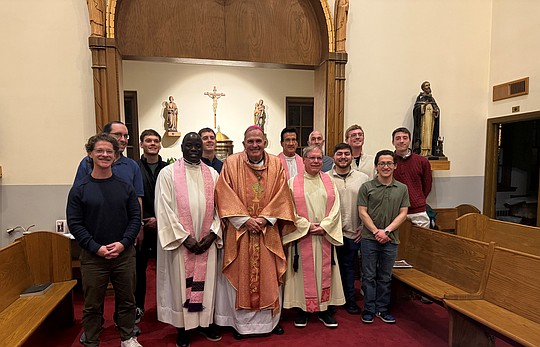Lord, will you teach us how to pray?
June 11, 2024 at 2:33 p.m.

As parents, we naturally want the best for our children. We want to protect them from anything that could harm them: war, violence, abuse, bullying, hatred, conflict, social media denigration. We’ve even invented terms to describe well-meaning but somewhat excessive protective inclinations – “helicopter” and “bulldozer” parent. Mothers and fathers realize that we cannot keep our kids wrapped in bubbles all their lives. They will be exposed to negative influences beyond our control. And many recent studies show the current generation of children is far more anxious, frustrated and distressed than any prior.
What should we do? What can we teach our children to help them cope with a world that shakes their confidence and can too often leave them in despair?
The answer is simpler than we may realize: We can teach them to pray.
Jesus’ first followers often witnessed him going off by himself after long periods of ministry, healing, and teaching.
They asked him, “Lord, will you teach us how to pray? (Luke 11:1-4)” In response, Jesus gives them – and us – the Our Father. In Jesus’ native Aramaic language, he begins with the word “A b b a .” Loosely translated, the word means “Papa” or “Daddy.” Jesus wants us to experience an intimate, loving trust in our relationship with God, and a nearness that helps us feel safe.
It is always a good thing to teach children the standard Catholic prayers (Our Father, Hail Mary, Glory Be, Act of Contrition, the Rosary, etc.), but more than that, children need to be taught that prayer is the way we communicate and build relationship with God. Through regular prayer children come to experience the nearness of God more meaningfully and learn to trust that God will always show them the best way to live.
This is what St. Paul meant 2,000 years ago when he wrote, “Pray constantly.”
Prayer does not require the “right words.” Scripture tells us that even when we don’t know what to
say, the Holy Spirit prays for us “with groanings that cannot be expressed in words” (Rom 8).
When we teach our children to pray from their hearts, they find that prayer creates a safe space for them to express honestly their deepest thoughts and cares. They learn they can tell God whatever they may be feeling, without fear.
They can even tell God they are angry with Him. It’s OK. God has big shoulders. Sometimes all they might need to say in prayer is, “God, please (help, guide, support, show) me.”
When children can live in the trusting, loving space that prayer fosters, the problems of the world and their own environments become less daunting.
When they know God always remains close to them, they understand that they don’t need to be afraid. As St. John wrote: “Perfect love drives out fear.”
If you want to help your children feel safe and secure, teach them to pray.
Mark Russoniello is parish catechetical leader in St. Robert Bellarmine Co-Cathedral, Freehold.
Faith at Home is a monthly column coordinated by the Diocese of Trenton’s Departments of Catechesis, Evangelization and Family Life, and Youth and Young Adult Ministry. For additional Faith at Home resources, visit dioceseoftrenton.org/faith-at-home.
WAYS TO PRAY
PRAY TOGETHER AS A FAMILY Children learn best by example. It is also important they understand it is OK to “go into [their] room and pray to God in the privacy of [their] heart (Matthew 6)” to develop their own personal relationship with Jesus.
PRAY WITH THE PSALMS
The Psalms display the fullness of emotion: sadness, joy, curiosity, understanding, despair, fear, wonder. These prayers, though, always end with words of hopeful trust in God’s help. Find books with child appropriate translations, like “Psalms for Young Children” by Marie-Helene Delval or “Children’s Letters to God” by Stuart Hample & Eric Marshall.
TAKE YOUR CHILDREN TO ADORATION
There is no better way to speak to Jesus than to sit quietly before the Eucharist in Adoration. Many parishes offer special times and chapels where the Eucharist is exposed for Adoration. Even if your parish does not, you can ask for access to the Church to pray before the tabernacle where Jesus is present.
Related Stories
Sunday, December 14, 2025
E-Editions
Events
As parents, we naturally want the best for our children. We want to protect them from anything that could harm them: war, violence, abuse, bullying, hatred, conflict, social media denigration. We’ve even invented terms to describe well-meaning but somewhat excessive protective inclinations – “helicopter” and “bulldozer” parent. Mothers and fathers realize that we cannot keep our kids wrapped in bubbles all their lives. They will be exposed to negative influences beyond our control. And many recent studies show the current generation of children is far more anxious, frustrated and distressed than any prior.
What should we do? What can we teach our children to help them cope with a world that shakes their confidence and can too often leave them in despair?
The answer is simpler than we may realize: We can teach them to pray.
Jesus’ first followers often witnessed him going off by himself after long periods of ministry, healing, and teaching.
They asked him, “Lord, will you teach us how to pray? (Luke 11:1-4)” In response, Jesus gives them – and us – the Our Father. In Jesus’ native Aramaic language, he begins with the word “A b b a .” Loosely translated, the word means “Papa” or “Daddy.” Jesus wants us to experience an intimate, loving trust in our relationship with God, and a nearness that helps us feel safe.
It is always a good thing to teach children the standard Catholic prayers (Our Father, Hail Mary, Glory Be, Act of Contrition, the Rosary, etc.), but more than that, children need to be taught that prayer is the way we communicate and build relationship with God. Through regular prayer children come to experience the nearness of God more meaningfully and learn to trust that God will always show them the best way to live.
This is what St. Paul meant 2,000 years ago when he wrote, “Pray constantly.”
Prayer does not require the “right words.” Scripture tells us that even when we don’t know what to
say, the Holy Spirit prays for us “with groanings that cannot be expressed in words” (Rom 8).
When we teach our children to pray from their hearts, they find that prayer creates a safe space for them to express honestly their deepest thoughts and cares. They learn they can tell God whatever they may be feeling, without fear.
They can even tell God they are angry with Him. It’s OK. God has big shoulders. Sometimes all they might need to say in prayer is, “God, please (help, guide, support, show) me.”
When children can live in the trusting, loving space that prayer fosters, the problems of the world and their own environments become less daunting.
When they know God always remains close to them, they understand that they don’t need to be afraid. As St. John wrote: “Perfect love drives out fear.”
If you want to help your children feel safe and secure, teach them to pray.
Mark Russoniello is parish catechetical leader in St. Robert Bellarmine Co-Cathedral, Freehold.
Faith at Home is a monthly column coordinated by the Diocese of Trenton’s Departments of Catechesis, Evangelization and Family Life, and Youth and Young Adult Ministry. For additional Faith at Home resources, visit dioceseoftrenton.org/faith-at-home.
WAYS TO PRAY
PRAY TOGETHER AS A FAMILY Children learn best by example. It is also important they understand it is OK to “go into [their] room and pray to God in the privacy of [their] heart (Matthew 6)” to develop their own personal relationship with Jesus.
PRAY WITH THE PSALMS
The Psalms display the fullness of emotion: sadness, joy, curiosity, understanding, despair, fear, wonder. These prayers, though, always end with words of hopeful trust in God’s help. Find books with child appropriate translations, like “Psalms for Young Children” by Marie-Helene Delval or “Children’s Letters to God” by Stuart Hample & Eric Marshall.
TAKE YOUR CHILDREN TO ADORATION
There is no better way to speak to Jesus than to sit quietly before the Eucharist in Adoration. Many parishes offer special times and chapels where the Eucharist is exposed for Adoration. Even if your parish does not, you can ask for access to the Church to pray before the tabernacle where Jesus is present.










